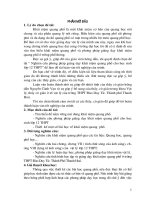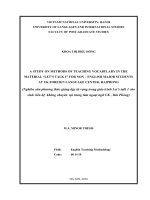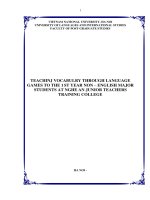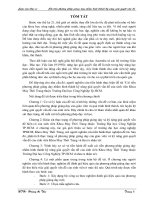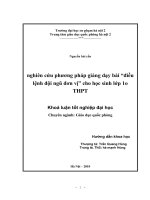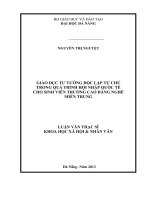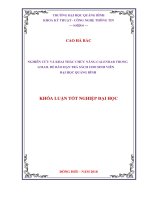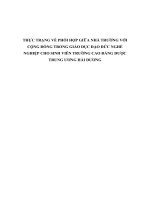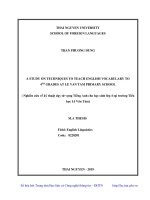nghiên cứu phương thức giảng dạy từ vựng trong giáo trình let's talk 1 cho sinh viên hệ không chuyên tại trung tâm ngoại ngữ uk, hải phòng
Bạn đang xem bản rút gọn của tài liệu. Xem và tải ngay bản đầy đủ của tài liệu tại đây (1.96 MB, 61 trang )
VIETNAM NATIONAL UNIVERSITY, HANOI
UNIVERSITY OF LANGUAGES AND INTERNATIONAL STUDIES
FACULTY OF POST-GRADUATE STUDIES
KHOA THỊ DIỆU HỒNG
A STUDY ON METHODS OF TEACHING VOCABULARY IN THE
MATERIAL “LET’S TALK 1” FOR NON – ENGLISH MAJOR STUDENTS
AT UK FOREIGN LANGUAGE CENTER, HAIPHONG
(Nghiên cứu phương thức giảng dạy từ vựng trong giáo trình Let’s talk 1 cho
sinh viên hệ không chuyên tại trung tâm ngoại ngữ UK , Hải Phòng)
M.A. MINOR THESIS
Field: English Teaching Methodology
Code: 60 14 10
HA NOI, 2010
v
TABLE OF CONTENTS
CANDIDATE’S STATEMENT i
ACKNOWLEDGEMENTS ii
ABSTRACT iii
LIST OF ABBREVIATIONS iv
TABLE OF CONTENTS v
PART A: INTRODUCTION 1
1. Rationale 1
2. Objectives of the study 1
3. Methodology 2
4. Scope of the study 2
5. Design of the study 2
PART B: DEVELOPMENT 4
CHAPTER 1: LITERATURE REVIEW 4
1. Vocabulary description in Language Teaching and Learning 4
1.1. Definition of vocabulary 4
1.2. Classification of vocabulary 4
1.2.1. According to the concept of morpheme 4
1.2.2. According to the meaning 5
1.2.3. According to the function of vocabulary items in a sentence 5
1.2.4. According to the sequence of use 5
1.2.5. Other classifications of vocabulary 6
2. Vocabulary in teaching and learning English 6
2.1. The importance of vocabulary in language teaching and learning 6
2.2. The complexity of learning vocabulary 7
2.3. The complexity of teaching vocabulary 8
2.3.1. Selecting vocabulary to teach 8
2.3.2. What needs to be taught? 9
2.3.2.1. Forms of a word 9
2.3.2.2. Meaning 10
2.3.2.3. Use of a word 10
2.3.3. When necessary to teach vocabulary? 10
2.3.4. How to teach vocabulary effectively and appropriately? 11
vi
3. Recent research in second language vocabulary teaching and learning 11
3.1. Incidental vocabulary learning 12
3.2. Explicit instruction 12
3.3. Developing independent learning strategies 13
3.4. Using games in vocabulary teaching and learning 14
4. Summary 14
CHAPTER 2: PRESENT SITUATION OF VOCABULARY TEACHING AND
LEARNING AT UK FLC, HAIPHONG 15
2.1. Learner’s language proficiency and vocabulary learning methods 15
2.2. Teachers and their teaching vocabulary methods 16
2.3. The material “Let’s talk 1” and material assessment 16
CHAPTER 3: DATA COLLECTION, FINDINGS AND DISCUSSION 19
3.1. Research methodology 19
3.1.1. The subject 19
3.1.2. Instruments for collecting data 19
3.2. Findings and discussion 20
3.2.1. Findings and discussions about students 20
3.2.1.1. Students’ attitude towards vocabulary and their difficulties in vocabulary
learning………………………………………………………………………………………20
3.2.1.2. Students’ vocabulary learning methods 22
3.2.1.3. Students’ attitude towards vocabulary exercises and activities in the course book
“Let’s talk 1” 24
3.2.1.4. Students’ comments and suggestions on vocabulary teaching and learning at UK
FLC………………………………………………………………………………………….24
3.2.2. Finding and discussions about teachers 28
3.2.2.1. Teachers’ attitude towards vocabulary teaching 28
3.2.2.2 Teachers’ vocabulary teaching methods 28
3.2.2.3. Teachers’ attitude towards vocabulary exercises and activities in the course
book “Let’s talk 1” 32
3.2.2.4. Teachers’ comments and suggestions on vocabulary teaching and learning at UK
FLC………………………………………………………………………………………….33
3.3. Interview 35
vii
CHAPTER 4: PROBLEMS AND SOME FEASIBLE SOLUTIONS FOR BETTER
TEACHING AND LEARNING VOCABULARY IN THE COURSE BOOK “LET’S
TALK 1’’AT UK FLC 37
4.1. Problems in the vocabulary teaching and learning in the course book “Let’s talk 1” at UK
FLC 37
4.1.1. Problems in the vocabulary teaching of non-major students in the course book “Let’s talk
1” at UK FLC 37
4.1.2. Problems in the vocabulary learning of non-major students in the course book “Let’s talk
1” at UK FLC 37
4.2. Some feasible solutions to improve the teaching of vocabulary in the course book “Let’s
talk 1” at UK FLC 38
4.2.1. Improving teachers’ classroom techniques for teaching vocabulary 38
4.2.2. Suggested vocabulary learning methods for students 40
4.2.3. Material development 41
Part C: CONCLUSION……………………………………………………………………44
1. Paper review 44
2. Limitation of the study and suggestions of further research 44
REFERENCES 46
APPENDICES I
Appendix 1: Questionnaire for students I
Appendix 2: Questionnaire for teachers V
Appendix 3: Interviews questions IX
iv
LIST OF ABBREVIATIONS
B.A : Bachelor of Art
M.A : Master of Art
FLC : Foreign Language Center
ELT : English Language Teaching
EFL : English as a Foreign Language
ELT : English Language Teaching
CLT : Communicative Language Teaching
GTT : Grammar Translation Teaching
L1 : First language
L2 : Second language
1
PART A: INTRODUCTION
1. Rationale
As the communication of politics, economy and culture between countries increases
rapidly, English, as an international language, plays an important role in our daily life. It is
also undeniable that English vocabulary as a major component of language learning has
been the object of numerous studies each of which has its own contribution to the field.
Laufer (1997) states that vocabulary learning is at the heart of language learning and
language use. In fact, it is what makes the essence of a language. Without vocabulary
speakers cannot convey meaning and communicate with each other in a particular
language.
In Vietnam, more and more people now are aware of the significance of English. It is
widely used and has been taught at schools, colleges, universities and many foreign
language centers as well for years. However, English teaching and learning in Vietnam has
still been far from satisfactory. Both teachers and learners have faced many difficulties in
teaching and learning English, especially in teaching and learning vocabulary. In UK FLC,
Haiphong, as for non-major students and teachers, vocabulary teaching has yet to be paid
due attention to as it deserves. It is a factual that vocabulary has not been taught as a
particular subject but has been integrated with four skills: listening, reading, writing and
speaking or often ignored during teaching.
Another reason is the course book ―Let’s talk 1‖. Applied since 2007, this book has
brought a lot of challenges for UK teachers and learners in terms of modern teaching and
learning methods as well as vocabulary treatment. However, up to now there has not been
any research on vocabulary teaching methods that help non-major students learn
vocabulary effectively.
As a teacher of English at UK FLC, the author does realize a number of problems that the
teachers and students encounter in teaching and learning vocabulary in the material “Let’s
talk 1‖. That is the reason why the author would like to carry out this research entitled ―A
study on methods of teaching vocabulary in the material ―Let’s talk 1 ―for non-major
students at UK FLC, Haiphong’’.
2. Objectives of the study
Firstly, the research concentrates on studying the current situations of the teaching and
learning vocabulary at UK FLC.
2
Secondly, this paper will make attempt to identify the main problems and reasons for less
effective vocabulary teaching and learning methods.
Finally, my study hopes to suggest some recommendations so as to help teachers and
learners have effective vocabulary teaching and learning methods.
With the objectives above, the research is carried out with an attempt to find out the
answers to the following questions:
1. What are the learners’ vocabulary learning methods and strategies at UK FLC?
2. What are the teachers’ vocabulary teaching methods and strategies at UK FLC?
3. What are tasks and activities should be used to help learners learn vocabulary
effectively?
3. Methodology
In this study, a combination of various methods is used to achieve its aims and objectives.
The qualitative and quantitative analyses are the main tools for analyzing the data, which is
collected from questionnaires and interviews with students and colleagues.
After the data is analyzed and discussed, the findings will be shown, some conclusions will
be drawn, and some suggestions will be raised in the thesis.
4. Scope of the study
Within the limit of a minor thesis, this study focuses on teaching and learning vocabulary
for non-major students at UK FLC with the course book ―Let’s talk 1‖. Specifically, this
minor thesis deals with the current problems which teachers and students encounter at the
center, investigating into teachers‟ and learners‟ vocabulary teaching and learning
methods. Basing on these discussions of these situations, some effective and feasible
solutions will be introduced.
5. Design of the study
The study is organized into introduction, the main part and conclusion
- The introduction includes the rationale, aims of the study, scope of the study,
methodology and design of the study as well.
- The main part consists of four chapters
Chapter 1 provides a thorough literature review relevant to the study
3
Chapter 2 deals with the investigation into the current situation of
teaching and learning vocabulary in the course book “Let’s talk 1‖ for
non-major students at UK FLC. In this chapter, learner‟s profile and
their vocabulary learning methods, the teachers‟ vocabulary teaching
methods are discussed comprehensively. Moreover, the course book
“Let’s talk 1‖ is also described.
Chapter 3 focuses on analyzing research questions and research
methodology. Findings and discussions on the study are also presented.
Chapter 4 presents some problems after analyzing data in chapter 3 and
suggests some feasible solutions for the effective application of
vocabulary teaching and learning methods are proposed.
- The last part of the study, “conclusion”, includes review, limitations and
implications of the study.
4
PART B: DEVELOPMENT
CHAPTER I: LITERATURE REVIEW
1. Vocabulary description in Language Teaching and Learning
1.1. Definition of vocabulary
Before proceeding to this study, it is necessary to clarify the definition of vocabulary. So
far, there have been different definitions of vocabulary. Each linguist gives his own
definition of vocabulary depending on the criteria that he or she considers the most
important in terms of linguistics, semantics, lexicology …etc.
Ur, in her book “A course in language teaching” defined vocabulary roughly “as the words
we teach in the foreign language. However, a new item of vocabulary may be more than a
single word: a compound of two or three words or multi word idioms”. (1996, p.60). Pyles
and Algeo” (1970, p.96) also gave their ideas about vocabulary. They said “when most of
us think about language we think first about words. It is true that the vocabulary is the
focus of language. It is in words that sounds and meanings interlock to allow us to
communicate with one another, and it is words that we arrange together make sentences,
conversation and discourse of all kinds”. These statements indicate that vocabulary is an
essential for part of language as Wilkin emphasized this with his saying “without grammar,
very little can be conveyed, without vocabulary nothing conveyed‖. According to Lewis
(1993, p.89), vocabulary “ may be individual words, or full sentences–institutionalized
utterance–that convey for social of pragmatic meaning within a given community”.
In summary, it can be concluded that vocabulary is the total number of all words that a
language possesses, ranging from a single word, two or three words items expressing an
idea to multi-word idioms of which meaning cannot be deduced from the analysis of the
component words but only understood in the sentences, or in contexts, etc…
1.2. Classification of vocabulary
According to Nu (2004), vocabulary can be classified in different ways according to
different criteria such as the concept of morpheme, the meaning, the function of
vocabulary items in a sentence, the sequence of use …
1.2.1. According to the concept of morpheme:
Based on this criterion, words are divided into three kinds:
Simple word:
5
A simple word is a word that consists of only one morpheme. Example: boy, man, radio,
book, paper, magnet, house, compute …
Derived word:
A derived word is one that that consists of a root and one or more derivational morphemes.
Example: careful, impossible, student mangles…
Compound word:
A compound word has at least two roots with or without derivational morphemes.
Example: rainbow, living room, guesthouse, two-tone, pancakes ….
1.2.2. According to the meaning:
There are two main kinds of meanings in a word, lexical meaning and grammatical
meaning.
Semantically, vocabulary is divided into notional words and functional words.
The notional words, whose meanings are lexical, form a great mass of the speakers‟
vocabulary. They address, name objects, actions, qualities and have meanings in
themselves. They are nouns, verbs, adjectives, adverbs, and so on…
The functional words, whose meaning is grammatical, only have their meanings in
relation to other words with which they are used. They are particles, articles, prepositions,
auxiliaries, conjunctions ….
Grammatically, vocabulary is categorized into different parts of speech such as nouns,
verbs, adverbs…
1.2.3. According to the function of vocabulary items in a sentence
In linguistics, vocabulary can be also be classified basing on functions as different parts of
speech such as nouns, verbs, adjectives, adverbs, prepositions and pronouns. Each part of
speech has its own position complying with certain grammatical rules and relating to one
another. Thus, the teacher is required to point out the function of each item to his students
and should teach them the family words as well. And the students during the course should
be aware of different functions of vocabulary items.
1.2.4. According to the sequence of use
Nation and Waring (2004) suggest two types of vocabulary–they are: high frequency
words and low frequency words. They state that although a language makes use of a large
number of words, not all of these words are equally useful. The question is how much
6
vocabulary should be learned by a language learner. Nation and Waring (2004, pp. 11)
give out the number of about 3000 high frequency words the learner needs to know. Nation
(2004) argued that after these high frequency words are learned, the next focus for the
teacher is on helping the learners develop strategies to comprehend and learn the low
frequency words of the language.
1.2.5. Other classifications of vocabulary
Methodologically, a foreign language leaner‟s vocabulary is classified as active and
passive vocabulary.
The active words are the words which the learner can understand, pronounce correctly, use
effectively in speaking and writing. The passive vocabulary is the words which the learner
cannot produce or use correctly by himself even when he wants to.
Melka (2004) discusses in detail the two notions of receptive and productive vocabulary.
These notions are based on reality; we all have experienced words which we can
understand perfectly well in a conversation or in a text, but we are totally unable to
remember when we want to use them productively. However, language teachers should
bear in mind that vocabulary acquisition is an incremental process. We need to rid
ourselves of the ―knows / doesn’t know‖ view of vocabulary, and realize that words will be
known to a greater or lesser degree, at least until they are fully mastered.
2. Vocabulary in teaching and learning English
2.1. The importance of vocabulary in language teaching and learning
Vocabulary is central to language and of critical importance to the typical language
learners (Zimmerman 1997b, p.5-19). However, teaching and learning vocabulary have
been neglected in second language acquisition throughout its varying stages. After decade
of neglect, lexis or vocabulary, which is now recognized as central to any language
acquisition process, has gradually become focus today. Vocabulary is no longer a victim of
discrimination in second language learning research. Because researchers have found that
vocabulary problems frequently interfere with communication and communication often
breaks down when learners lack necessary vocabulary. Learners and experienced English
teachers also know well how important vocabulary is (Zimmerman 1997b, p. 5-19).
Regarding to this matter, Nation and Waring (2004) also said that ―substantial vocabulary
knowledge is always a prerequisite to the performance of language skills. Vocabulary
7
enables language use, language use enables the increase of vocabulary knowledge, and
knowledge of the world enables the increase of vocabulary knowledge and language use
and so on.‖
What is more, in learning a language, it is very important to learn as many words as
possible. All foreign language learners and their teachers have intuitively known for a long
time that learning a foreign language involves the learning of a large number of words.
Lewis (1993, p.23) says that learning vocabulary is the core task in second language
acquisition and any language skills of listening, speaking, reading, writing, translating,
cannot exist without vocabulary. Words are the currency of communication. A robust
vocabulary improves all area of communication. Consequently, the teaching and learning
of vocabulary are significant in learning a foreign language, especially in the light of the
communicative approach.
To sum up, vocabulary plays a crucial role in language learning. In order to succeed in
learning a language, it is very essential for learner to master its vocabulary.
2.2. The complexity of learning vocabulary
When asked about difficulties in learning foreign language, almost the students said that
the biggest problem is learning vocabulary. They say that the hindrance of learning
vocabulary is because they forget easily the words they have learnt. Sometimes, even they
know the word meaning, they feel confused in using it in terms of grammar or semantics.
Moreover, when being asked about the learning methods of vocabulary, the answers show
the poor knowledge about this field. For them, it seems just learning vocabulary is to
perceive a list of new words they encounter in learning English books with Vietnamese
meaning. In fact, the learning vocabulary is not as simple as that. It is a complex process
related to much knowledge around a vocabulary item from the need to master. According
to Ellis and Sinclair (1989), mastering a vocabulary item should base on the following
criteria:
- Understand the word when it was spoken or written.
- Remember to be used when needed.
- Use the correct word in terms of semantics.
- Use correct grammatical words.
- From the standard pronunciation.
- Mastering the words may or may not be used with it.
8
- Spelling words correctly.
- Use a suitable context.
Also, according to these linguists, not only one or several times learning a word the
learners can master or remember but at least 7 or 16 times learning the vocabulary item in
different contexts do they need to learn and use it.
2.3. The complexity of teaching vocabulary
To teach vocabulary effectively, the teacher needs to solve four problems related:
1. How to select the vocabulary to teach?
2. What needs to be taught?
3. When is the right time to teach vocabulary?
4. Which method should be chosen to teach vocabulary effectively and appropriately?
2.3.1. Selecting vocabulary to teach
Gains and Redman (1986) proposed some main criteria as frequency, (p.58-59) cultural
factors, (p.59) expediency and student’s need and level, (p.59-61). In teaching, the teacher
should select the most frequently used words to teach because ―the high frequency of an
item is no guarantee of usefulness, but there is obviously a significant correlation between
the two so it is worth examining some of the work on frequency word-counts‖. In the other
words, the chosen vocabulary to teach should appropriate to student‟s level and respond to
their needs. For example, elementary students will find it difficult in learning vocabulary
which is for advance learners. Expediency is an important criterion that needs to be
concerned as the classroom is a world by itself which requires specific types of vocabulary
such as grammatical terminology and activity instructions. The influence of cultural factors
can be easily recognized in the educational environmental where the learners have different
background and come from different countries. They need different words to express their
ideas in the second language.
According to Gains and Redman (1986) there are four main sources of vocabulary
Through the course book: vocabulary can be found in the written and spoken texts,
activities for presentation and practice of grammatical structures, testing exercises… in the
course book.
Through supplementary materials (not designed specifically for vocabulary development)
provided by the educational institution or selected by teachers. This may include texts,
drills, role plays, video …
9
Through the students: A wide range of unanticipated and unpredictable items will
certainly occur from the students enquires, queries, and errors…
Through specific vocabulary activities designed by language teachers for their particular
group of students.
Nu (2004) also said that there may occur many new words in a lesson. However, it is the
teacher who will decide for vocabulary selection. In fact, a language leaner can only absorb
from 5 to 7 new words in a lesson. So, the teacher should select to teach active words
which help students understand or complete a task. The other new words can be guessed
from the contexts or even translated if necessary.
2.3.2. What needs to be taught?
2.3.2.1. Forms of a word
Pronunciation and spelling
Words that are difficult to pronounce are usually difficult to learn (Rodgers, 1969; Ellis
and Beaton, 1993). Words that are easy to pronounce can more easily be held in working
memory and thus have a greater chance of entering long-term memory. Thus the words
introduced early in an English course should be easy for learners to pronounce. Substantial
listening practice and a small amount of guided pronunciation practice can make it easier
for words with unfamiliar sounds to be learned.
Grammar
Just as words change, according to their grammatical meaning, so the use of certain words
can trigger the use of certain grammatical patterns. We make a distinction between
countable and uncountable nouns. The former can be singular and plural. The latter can
only be singular; we can say ―one chair‖ or ―two chairs‖ but we cannot say ―two
furniture‖. This difference, then, has certain grammatical implications. ―Chair‖ can
collocate with plural verbs whereas ―furniture‖ never can.
Therefore, knowing a word means far more than just understanding its meaning or one of
its meanings. Somehow our teaching must help students to understand what this
knowledge implies both in general and for certain words in particular. By being aware
what is stated above, students will be more receptive to the contextual behaviour of words
when they first see them in texts or readings and they will be better able to manipulate the
meanings and forms of the word.
10
2.3.2.2. Meaning
Denotation meaning
The denotation meaning is often the sort of definition given in dictionary which refers or
point out things or concept. For example: a bird: a creature that is covered with feathers
and has two wings and two legs. Most of bird can fly.
Connotation meaning
A less obvious component of the meaning of a word is its connotation. This is association,
or the positive and negative feelings the word evokes which may or may not be indicated
in a dictionary definition. A stubborn person may be described as being either strong-
willed or pig-headed. Although these have the same literal meaning (i.e. stubborn), strong-
willed connotes admiration for the level of someone's will, while pig-headed connotes
frustration in dealing with someone.
Meaning relationship
Meaning relationship indicates the ways the meaning of one item relates to the meaning of
the others. There is a variety of this relationship such as synonyms, antonyms, hyponyms,
co-hyponyms or co-ordinates and super-ordinates. The language teachers can exploit these
to clarify the meaning of a new word to help the students practising or preparing the testing
materials.
2.3.2.3. Use of a word
To all language learners, knowing how to use the word appropriately should be concerned
as it indicates whether a particular item is appropriate one to be used in a certain context.
Using a new word well can help the learners collocate it with other words accurately as
well. It is noted that the students should be taught forms, meaning, and use of words in
vocabulary lesson so that they can learn and revise vocabulary items effectively and
sufficiently.
2.3.3. When necessary to teach vocabulary?
In learning foreign language, it is important that learners know how to a certain vocabulary
item to master four language skills such as speaking, listening, writing and speaking. Thus
vocabulary teaching should precede teaching skills. The teachers do pre-teach vocabulary
in a reading or listening task: in other words, new vocabulary should be introduced in
contextual situation for students before assigning reading or listening task.
11
2.3.4. How to teach vocabulary effectively and appropriately?
Thornbury (2002) discusses several techniques and procedures a teacher might choose to
help learners acquire new vocabulary items. The underlying premise is that sometimes
there is a need for the instructor‟s direct intervention in the teaching of selected vocabulary
items. Since Lewis (1997) claims that most of the activities used in the Communicative
Approach are compatible with the Lexical Approach, then what teachers need to do is
adapt activities so that the tasks have a clear lexical focus. To achieve this goal, Lewis
(1997, p.205) points out that teacher should do the following:
• Consciously take every chance to expand the learners’ phrasal lexicon.
• Develop learners’ awareness of word-grammar as well as sentence grammar.
• Highlight Fixed Expressions and prototypical examples, so ensuring learners have
maximum benefit from the language they meet.
• Encourage accurate observation and noticing by learners, but without excessive
analysis.
• Use many different ways to increase learners’ awareness of the value of noticing,
recording and learning multi-word items.
• Encourage learners to keep a well-organized lexical notebook.
• Encourage lexical, but not structural, comparison between L1 and L2.
• Help learners to hear and learn language in multi-word units.
• Talk more informally, but in a carefully controlled way, with your class.
• Tell simplified anecdotes (true or otherwise): increase carefully-controlled teacher
taking time.
• Take a global, holistic view of pronunciation.
• Value successful language at all times, even if it is not formally accurate.
Furthermore, in the preface to his second book Implementing the lexical approach, Lewis
(1998, p. 3) argues that implementing the lexical approach in your classes does not mean a
radical upheaval, likely to upset colleagues, parents and learners.
3. Recent research in second language vocabulary teaching and learning
As we enter the 21
st
century, acquisition of vocabulary has assumed a more important role,
and as some would argue the central role in learning a second language (Lewis, 1993).
Many recent researches have contributed much in finding out the approaches to highly
effective vocabulary teaching and learning to help students store and retrieve words in the
12
target language. According to the linguists, there are three approaches: incidental learning
(indirect or implicit learning), explicit instructor and independent learning strategies.
3.1. Incidental vocabulary learning
Many linguists have made the definition of incidental learning. Nation (2001, p.232)
defines the incidental vocabulary learning as an important strategy in vocabulary learning.
It refers to the learning, which occur without specific intention to focus on vocabulary. One
can develop vocabulary knowledge subconsciously while being engaged in any language
activities especially reading.
Other defines the incidental vocabulary as that there is no special attention given to
linguistic problems unless they arise spontaneously in the course of instruction.
Particularly, it involves the use of unfocused communicative tasks which are designed to
elicit general sample of the language rather than specific forms (Ellis, Basturkman &
Loewen 2002, p.419-432)
From the views mention above, incidental learning of vocabulary can be defined as a kind
of learning method from reading, listening, writing and speaking to language use while
learners‟ main attention focuses on the information of passages or texts. This method
includes learning from extensive reading, taking part in conversations, listening to stories,
watching English movies, listening to the radio or other exposure of input and output both
out of and in classrooms (Nation 2001, p.232)
3.2. Explicit instruction
Explicit instruction depends on identifying specific vocabulary acquisition targets for
learners. It also involves diagnosing the words learners need to know. Explicit instruction
requires the language teachers provide opportunities for intentional learning of vocabulary,
for elaborating word knowledge and developing fluency with known vocabulary.
Intentional learning of vocabulary is a traditional and common method in teaching
vocabulary. According to Nation (1990), Paribakht and Wesche (1996), Zimmernan (1997)
intentional learning through instruction also significantly contributes to vocabulary
development and translation has a vital useful role in vocabulary learning.
Ellis called intentional learning the planned method involving the use of tasks designed to
forms which have been selected ahead by teachers (2002, p.1-46 ), whereas, Schmitt (2000
p.120) demonstrates that can be called explicit learning of vocabulary and it focuses
13
attention directly on the information to be learned. In addition, intentional teaching of
vocabulary in classroom is often the teacher-centered class.
3.3. Developing independent learning strategies
It is obviously impossible for students to learn all the vocabulary they need in the
classroom. Thus, helping students learn how to continue to acquire vocabulary on their
own is essential in learning foreign language. There is no need to motivate the students to
want more words under their command. When vocabulary gets the attention it deserves,
that is, when instructors model explicit methods of vocabulary acquisition which require
deep processing and plan re-encountering of words, students not only learn words but
experience (Resnick, 1989).
Independent strategy involves practicing guessing from contexts and training learners to
use dictionary. It is clear that guessing context is a complex and often difficult strategy to
carry out successfully” to guess successfully from contexts, learners need to know about 19
out of 20 words (95%) of a text which requires knowing 3,000 most common words (Lui
and Nation, 1999). However, helpful context are rare and difficult to guess the meaning of
words in a long and difficult context.
Nation and Coady (1988, p.104-150) introduced a five - step procedure that students could
follow:
Determine the part of speech of unknown word.
Look at the wider context.
Guess the meaning of unknown word.
Look at the intermediate context
Check that the guess is correct.
Liu and Nation (1985) also suggest that this method should be practiced in class rather than
just their own individual practice to help learners can learn and share more experiences.
The second independent learning strategy mentioned below is using dictionaries in
vocabulary learning process. Day and Luperscu (1995) when talking about the use of
dictionary in vocabulary acquisition, point out those students who used a dictionary scored
significantly better on vocabulary test than the students who did not. Since dictionaries are
effective learning tools, learners should know when and how to use them efficiently.
Learning the meaning of words will be more effective if dictionaries can be used in
combination with context and word elaboration activities.
14
3.4. Using games in vocabulary teaching and learning
Many experienced textbook and methodology manuals writers have argued that games are
not just time-filling activities but have a great educational value. Lee holds that most
language games make learners use the language instead of thinking about learning the
correct forms (1979:2). He also says that games should be treated as central not peripheral
to the foreign language teaching programme.
A similar opinion is expressed by Richard-Amato, who believes games to be fun but warns
against overlooking their pedagogical value, particularly in foreign language teaching.
There are many advantages of using games. "Games can lower anxiety, thus making the
acquisition of input more likely" (Richard-Amato 1988:147). They are highly motivating
and entertaining, and they can give shy students more opportunity to express their opinions
and feelings (Hansen 1994:118). They also enable learners to acquire new experiences
within a foreign language which are not always possible during a typical lesson.
4. Summary
In summary, in chapter 1, the literature review relevant to the research is comprehensibly
and presented. Vocabulary issued are mentioned including vocabulary description, the role
of vocabulary in language teaching and learning as well as recent researches in teaching
and learning vocabulary.
15
CHAPTER 2: PRESENT SITUATION OF VOCABULARY TEACHING AND
LEARNING AT UK FLC, HAIPHONG
It can be said that the learners‟ success or failure in learning foreign language especially in
learning vocabulary depends much on teachers, learners‟ background, their needs and
motivation, learning environment and the materials as well. Furthermore, they are decisive
factors towards the success of each EFL course.
In this chapter, I would like to give a brief overview on learners‟ English background and
vocabulary learning methods, teachers‟ methods of vocabulary teaching at UK FLC. What
is more, a brief description of material and material assessment are also mentioned.
2.1. Learner’s language proficiency and vocabulary learning methods.
Most of the learners at UK FLC are non-major students. They are the students from
universities and colleges in Haiphong. Many of them have been studying English since at
high school while the others have not. In addition, some of the students in the city have
English learning conditions that are more standard than those in the countryside.
Therefore, students in UK FLC have different English background. Besides, English is a
compulsory subject at university so the main purpose of those students is firstly to pass
exams at their school and then to get good job after graduation. It is a factual that a large
proportion of the total numbers of the students are false beginners even English have been
introduced in the secondary curriculum for years. Thus students‟ language proficiency has
a great variety of ability. This has caused certain problems to the teaching and learning
English in general and learning English vocabulary in particular at UK FLC.
One thing can be easily realized when talking to these learners is that all of them are wish
to have good English communicative skills but they cannot communicate well. The main
reason here because at high school, they are familiar with their teacher‟s traditional
teaching methods like “grammar focus”, and the expectation of the outcome is just only the
students marks in English written tests. The students only write words on paper with
translation into Vietnamese and try to learn them by heart. The students; therefore; have
little chances getting involved in pair work or group work activities such as discussion,
games …
All the factors mentioned above that make students have certain difficulties in listening,
reading, especially speaking which help students improve their vocabulary. And the reason
for all of these obscurities is due to the shortage of essential vocabulary knowledge.
16
2.2. Teachers and their teaching vocabulary methods
There are about 20 teachers with nine full time teachers and the others work there as part-
time jobs at UK FLC, in which only 30 % is M.A of English. They have been teaching
English for years. Most of the teachers have to teach in a large and crowded class with over
30 students and the duration for each English communicative course is 2 months only.
From the observations and talks to the teachers and their students, it can be obviously seen
that most of the teachers favor traditional method; that is teacher- centered. When teaching
vocabulary, they prefer translation and making–up sentences tasks. The teachers
themselves are too deeply influenced by grammar-translation method. As a result,
vocabulary learning activities is not adequate enough for students to practice their
vocabulary. The activities to practice the learnt vocabulary are often assigned to students as
homework rather than class work without checking. This leads to the vocabulary learning
and teaching is usually not as effective as expected.
2.3. The material “Let’s talk 1” and material assessment.
Although historically the importance of vocabulary has been minimised, some of the more
recent published EFL course books have adopted a systematic approach to vocabulary
learning and have become increasingly aware of the importance of developing vocabulary
learning strategies. Thus, to help teachers to access vocabulary component of the course
books systematically, in the book “Working with words‖: A guide to Teaching and
Learning Vocabulary (Gains, R & Redman, S. 1999), the authors suggest the checklist
which should help the teachers to select the suitable material and supplement the lexical
items and material items as well.
SELECTION
Is there a lexical syllabus?
Vocabulary in course books
How are vocabulary items grouped?
How many items are introduced at once?
LINGUISTIC CONSIDERATIONS
To what extent does the course book assist both cleaner and teacher in clarifying
meaning, dealing with style and connotation, or contrasting items which cause
difficulty?
17
Does it provide phonemic transcriptions and indicate the part of speech of new
items?
How thoroughly does it deal with the use of items?
METHODOLOGY
What learning approaches are selected?
Does the teachers‟ book suggest teaching procedures?
Are practice and testing activities provided?
Is the vocabulary recycled?
How are learners encouraged to consolidate and widen their vocabulary outside the
classroom?
Does the course book contain useful visual material?
Does the course book anticipate vocabulary needed for skills activities?
Compared to the criteria above, it can be said that Let’s talk 1 (Leo Jones, 2002) is a good
book for the learners who want to learn English with communicative purpose. It has been
used for 3 years at UK FLC as official material to learn general English. Designed by Leo
Jones, a well-known ELT writer, Let’s talk 1 is aimed at developing oral communication
skills for students at the high-beginning/low-intermediate level including and innovating
topics that encourage students to express their feelings, ideas and opinions. The book
consists of 16 four–page thematic units divided into two-page lesson and four review
puzzles lessons with a lot of speaking and listening activities and activities are presented
for practising vocabulary (at least two vocabulary exercises per unit in the Student book).
The vocabulary provided in this book are the words and phrases which are useful in daily
life such as weather and climate, free time, food and drink, entertainment, travel and
tourism … Vocabulary exercises are given in pre-listening tasks or pre-speaking tasks so
that the teachers can combine them with other skills to teach students new words before
practising.
The table below shows nine types of vocabulary exercises in the material.
Types of vocabulary exercises
1.Put the words given in the correct group
6.Search words in square
2.Fill in the blanks with the words given
7. Put the scrambled letters in the correct
orders.
3.Find synonyms /antonyms
8. Look at a picture and choose the words
18
that describe the picture.
4.Do a crossword
9. Complete a vocabulary network with the
words given.
5.Match words to make collocation
Besides, there are other types of vocabulary tasks in combination with listening, speaking
and reading skills such as Listen and fill in the blanks with a suitable word, Use the words
in the lesson to do a speaking task or Listen and choose the correct answers …
However, this book focuses much on speaking and listening activities while the tasks for
vocabulary practising are limited. Additionally, the book is written for the learners who
want to learn English as their second language at the level of high-beginner. Therefore, the
number of vocabulary in the book is rather large for learners to study during their course
which lasts for a short time. These things cause much difficulties and inconvenience for
both teachers and learners in teaching and learning vocabulary.
In summary, a brief overview on learners‟ English background and vocabulary learning
methods, teachers ‟methods of vocabulary teaching at UK FLC was given about in this
chapter. What‟s more, the course book “Let’s talk 1‟‟ was also mentioned and assessed.
The crucial factors affecting teaching and learning were clearly pointed out. In next
chapter, an effort will be made to find out the problems that the teachers and students at
UK FLC face in teaching and learning vocabulary based on the data collected through
survey questionnaires.
19
CHAPTER 3: DATA COLLECTION, FINDINGS AND DISCUSSION
In chapter one, I present the rationale, the aims, and objectives, scopes and the setting of
this study. Chapter two introduced a review of literature related to teaching vocabulary has
been discussed. The chapter that follows presents the research methods and techniques for
data collection. This is following discussion of the instruments of the research and the
procedure of the data.
3.1. Research methodology
3.1.1. The subject
The study is conducted with the participants of 20 full-time teachers and 200 non-major
students at UK FLC. The students under investigation are mainly in the second term of the
first year at four universities and other colleges in Haiphong. They are between 18 and 20
years old, both female and male, randomly selected from eight different classes at UK
FLC. These students have finished the “Let‟s talk 1‟‟course. They all have similar
background, that is, they are supposed to be at high- beginner level of English. Of the 20
teachers, nine are full-time teachers and 11 are part –time teachers at universities or
colleges in Haiphong. They all have Diploma Degree in English; six of them have M.A
Degree.
3.1.2. Instruments for collecting data
The study aims at investigating into vocabulary teaching and learning methods in the
course book “Let‟s talk 1‟‟ at UK FLC to help non–major students learn vocabulary more
effectively. Given the complexity of the issue, the study employed a variety of research
instruments and source of data in order to bring about the reliable information. That is the
reason survey questionnaires and informal interviews for both teachers and students are
used in this research. A combination of two research methodologies: qualitative and
quantitative; is chosen in order to answer the research questions which are mentioned in
the objectives of the study. Action research is also used in this research to investigate
teaching and learning so as to improve their own and their students‟ learning.
Questionnaires
The questionnaires for both teachers and students were administered to get information
concerning:
- The students‟ attitude towards the importance of teaching and learning vocabulary
- Students‟ vocabulary learning methods
20
- Students‟ attitude towards vocabulary exercises and activities in the course book
―Let’s talk 1‖
- Students‟ comments and suggestions on vocabulary teaching and learning at UK
FLC.
- The teachers‟ attitude towards the importance of teaching and learning vocabulary
- The teachers‟ vocabulary teaching methods
- The teachers‟ attitude towards vocabulary exercises and activities in the course
book ―Let’s talk 1‖
- Teachers‟ comments and suggestions on vocabulary teaching and learning at UK
FLC.
Interview
To guarantee the reliability and validity of the information and to be able to offer a more
comprehensive analysis and recommendations, the writers also used feedback from
informal interview with teachers/students in classes at UK FLC. In this research, the
interviews were taken placed after the analysis of the two survey questionnaires‟ data so
that the researcher could clarify the information which is unclear from the surveys and seek
more data needed.
3.2. Findings and discussion
In this part, research data will be analyzed in detail according to the classifications in the
questionnaires which are designed for both teachers and learners. As mentioned in the
previous chapter, the questionnaires focus on four main problems: the role of vocabulary in
teaching and learning English, vocabulary aspect in the course book ―Let’s talk 1 “ ,
teachers‟ and learners‟ teaching and learning methods, teachers‟ and learners‟ comments
on vocabulary teaching at UK FLC and their expectations .
3.2.1. Findings and discussions about students
3.2.1.1. Students’ attitude towards vocabulary and their difficulties in vocabulary
learning
Q1: What do you think about the role of vocabulary in learning English, in your opinion?
Options
Students (%)
a. Very important
72%
b. Rather important
28%

